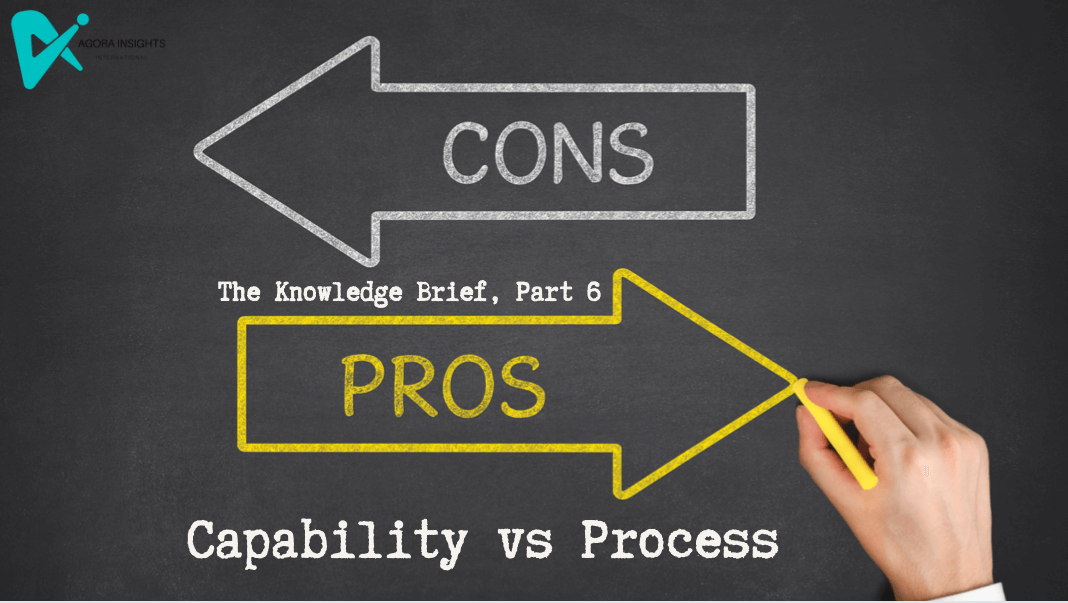You may believe that this step should be simple and quick because all that is required to conduct current state analysis is to look around and then move on to a solution. After all, the people within the organisation are constantly immersed in the current state. However, it is precisely because of this immersion that this step is required. Our role as business analysts is to remove assumptions about what is perceived and provide information that is based on an understanding of the business need and how it relates to how the enterprise operates today. This assists us in visualising the baseline and the context for change.
In this section, we will discuss why it is critical to begin current state analysis, the differences between capabilities and processes, and some techniques for mapping the current state.
Why starting with the current state analysis is essential

There can often be a gap between what you think is happening and what is actually happening. Just as a builder or architect would need to understand what the current state of a house is prior to renovation, so too should we understand what is happening today. Once the current state of a building is understood, the requirements of what needs to happen become more obvious. Which is why the focus of part 6 in The Knowledge Brief is on identifying the actual steps that are being followed, not the steps you hope are being followed so that we can avoid obvious gaps when implementing a solution.
Acting as an investigative journalist, the BA would want to map out the current situation and plot how things work, bringing in the relevant players, their roles, and how they fit into the background or the investigation. This exercise can be very tricky because many people feel that you are waisting their time
A current state analysis would look at the particular area of the business which has been derived from our previous 5 parts of our Knowledge Brief. The key is to do research that includes collecting data, making observations, and analysing the results. And by using metrics we have identified in part 3 of our Knowledge Brief, we can test and capture out how well the company is meeting its needs and what requirements and gaps there are.
Should I use capabilities or processes in my change project?

There are typically two types of approaches when analysing the current state. Capabilities describe what an enterprise does while processes describe how a business delivers to its stakeholders. Both capabilities and processes include the knowledge the enterprise has, the products and services it provides, the functions it supports, and the methods it uses to make decisions. Business analysts may use:
- A capability-centric view of the enterprise when looking for innovative solutions that combine existing capabilities to produce a new outcome. A capability-based view is useful in this situation because capabilities are generally organized using functional decomposition and can be very simply heat-mapped to quickly identify areas that are not functioning effectively.
- A process-centric view of the enterprise when looking for ways to improve the performance of current activities. A process-based view is useful in this situation because processes are organized in an end-to-end fashion across the enterprise to deliver value to its customers, making it easier to ensure that a change does in fact increase performance.
There are advantages and disadvantages to both approaches, for instance
- capability maps are very helpful if they are available at the start of the project as they provide a quick view of the areas impacted but take some time to develop if there's no architecture to begin with.
- mapping a process can be fairly quick but it won't provide you with a broader understanding of the business and the impacts the change has in the long term.
Use business architecture to understand the broader impacts.
As we find a direct reference to business architecture in BABOK 6.1.4.6, no part of the current state should be assessed without taking into account the rest. In order to suggest changes that will actually work, business analysts need to know how all of these parts of the current state fit together. If these needs aren't taken into account or won't be met by a proposed transition or future state, we might not be adding value to the organisation.

Typically, your business architecture will have, at a minimum, the core capabilities. Most of the time, the current business architecture meets a wide range of business and stakeholder needs as it contains a knowledgebase. In this video, I explain how business architecture helps connect the dots in the organisation by providing the breadth of information required in change initiatives and thereby validating the work that is being undertaken.
What is a business capability?
A capability map is one of the most powerful and flexible tools for business architecture and use in change. It's also one that gets everyone in the organisation interested in architecture almost right away. On a single page, we can show a lot of important information about what the organisation is and does, as well as how it ties all of its activities together into a single whole. In this video with Bruce Kay, he gives a brief but useful overview of why and how to make a capability-map for your organisation.
How to create a capability model while considering processes
This video by Dr. Raj Ramesh is great to understand the value of capability modelling. Managers can use capability modelling to examine and make decisions about the entire enterprise. For example, with the basic model in place, you can use it as a heat map to identify capabilities that have to be prioritised based on your strategy. Which capabilities require the most resources?
Each step in the process uses a specific set of capabilities that either you or your partners provide. For example, if you offer fast delivery service to your customers as a competitive advantage, you better have the mechanisms in place to deliver on that promise.
A few things that you can achieve with the help of business capability mapping are as follows:
- Determine what the company is doing now and what can be done to meet current and future challenges.
- Defining a company's 'what' rather than focusing on how the company does it.
- It serves as a common platform for discussion and planning.
- Provides a direct link between strategy and strategy execution in an organisation.
- Business capability mapping aids in risk assessment and planning for future endeavours.
Making the invisible visible with process mapping
In a factory or warehouse setting, processes tend to be clear and obvious. Machines carry out tasks in a way that is standardized and visible. Materials are pushed out on an assembly line. Products are boxed up in cardboard and loaded on delivery trucks.
In an office, on the other hand, processes aren’t so readily apparent. Think of the steps involved in getting a marketing campaign from the brainstorming session to the finished deliverables — it’s a far more complicated, and far less visible process than cutting metal or packaging products.
One technique for defining these processes is known as process mapping or process modelling. It involves approaching typically invisible processes and depicting them visually so they can be analyzed. From there, deficiencies can be determined and improved, and new, more efficient processes can be established.
In this video, Angelo Kalevela provides a walkthrough of the basics of business process modeling with a realistic example using Draw.IO (http://draw.io/) which is completely free software that you can use in the cloud ( or download a desktop version.
Key Learning
- The focus of part 6 in The Knowledge Brief is on identifying the actual steps that are being followed, not the steps you hope are being followed so that we can avoid obvious gaps when implementing a solution.
- Our role as business analysts is to remove assumptions about what is perceived and provide information that is based on an understanding of the business need and how it relates to how the enterprise operates today.
- There can often be a gap between what you think is happening and what is actually happening.
- Using metrics from part 3 of our Knowledge Brief, we can test and capture out how well the company is meeting its needs and what requirements and gaps there are.
- In order to suggest changes that will actually work, business analysts need to know how all of these parts of the current state fit together.
- Once the current state is understood, the requirements of what needs to happen become more obvious.
Summary
In this section of The Knowledge Brief, we will discuss why it is critical to begin current state analysis. Our role as business analysts is to remove assumptions about what is perceived and provide information that is based on an understanding of the business need and how it relates to how the enterprise operates today. We will also look at the differences between capabilities and processes, and some techniques for mapping the current state. Capabilities and processes describe how a business delivers to its stakeholders. Business analysts may use a capability-centric view of the enterprise or a process-based approach. Use business architecture to understand the broader impacts.
References:
© The Knowledge Brief is a product of Agora Insights Ltd. All rights are reserved
Post sponsored by Agora Insights Ltd

Post a Comment